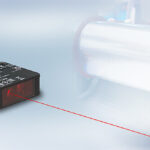Thanks to an adjustable sound cone and small dead zone, the new Leuze ultrasonic sensors of the 420B and 412B series can be used for many different applications.

If you’re looking to reduce the number of different sensors used in your systems, the 420B and 412B series from Leuze are the right choice: The new ultrasonic sensors are available with adjustable sound cone and as switching (HTU) or measuring (DMU) sensors – this allows extremely flexible application. The sound cone can be set via an IO-Link interface to the three ranges “narrow”, “medium” or “wide” and thus adapted to the respective application. As a result, the ultrasonic sensors operate with maximum precision: They are able to detect reliably in situations where optical sensors are pushed to their limits. They also detect glossy, reflective, very dark or transparent surfaces as well as liquids without problem. The 420B series includes ultrasonic sensors in compact cubic plastic housings. It replaces the 420 series. With the new devices, users benefit from smaller dead zones with the same or a higher sensor operating range. The 412B series complements the range of cylindrical sensors in M12 housing with devices featuring IO-Link and analog output.

The ultrasonic sensors of the 420B series have an adjustable sound cone. A narrow, medium or wide sound cone can be selected depending on the application. This allows, for example, fill levels to be monitored through differently sized container openings
Maximum flexibility in the red housing
Thanks to their adjustable sound cone, IO-Link interface and two switching outputs, the HTU420B ultrasonic sensors in the red housing are suitable for challenging detection tasks. For example, two fill levels can be detected or two positions can be monitored simultaneously. The adjustable sound cone turns the sensors into flexible all-rounders. A narrow sound cone, for example, is suitable for detecting a fill level through small container openings. In its wide setting, the sound cone in turn captures larger areas – ideal in the case of bulk material or diffusely reflective objects with complex surface or structure. Practical: An interruption filter detects brief changes in measurement within a certain interval caused by interfering objects (e.g. an agitator). The sensor suppresses these interfering signals via the IO-Link interface, thereby ensuring a seamless production process.
For the precise measurement of distances
Moreover, to measure distances, system operators can make use of the DMU420B and DMU412B ultrasonic distance sensors. The devices have an analog output (either current or voltage), an IO-Link interface as well as an adjustable sound cone.

The DMU420B ultrasonic distance sensors continuously deliver an analog output signal (either current or voltage) to the machine control. This allows system operators to monitor e.g. roll diameters to ensure that the rolls are changed in a timely manner. The glossy surface is detected reliably.
Economical solution in the black housing
The Sensor People from Leuze also offer the HTU420B ultrasonic sensors in a standard design with black plastic housing. As an economical solution with one switching output (push-pull), they are suitable for simple detection tasks. Both variants are available in the operating ranges from 10 to 250 millimeters, 15 to 500 millimeters as well as 20 to 1000 millimeters. The HTU412B series has an operating range of 15 to 500 millimeters.
Fast setup
The cubic sensors measuring 20.5 x 41.0 x 15.0 millimeters are extremely compact. The cylindrical sensors of the HTU412B series too are just 50 millimeters long. They are therefore also particularly suitable for applications in constrained spaces. All types can be parameterized quickly: Easy setup and operation is possible using the teach button, via the teach input or via IO-Link.







